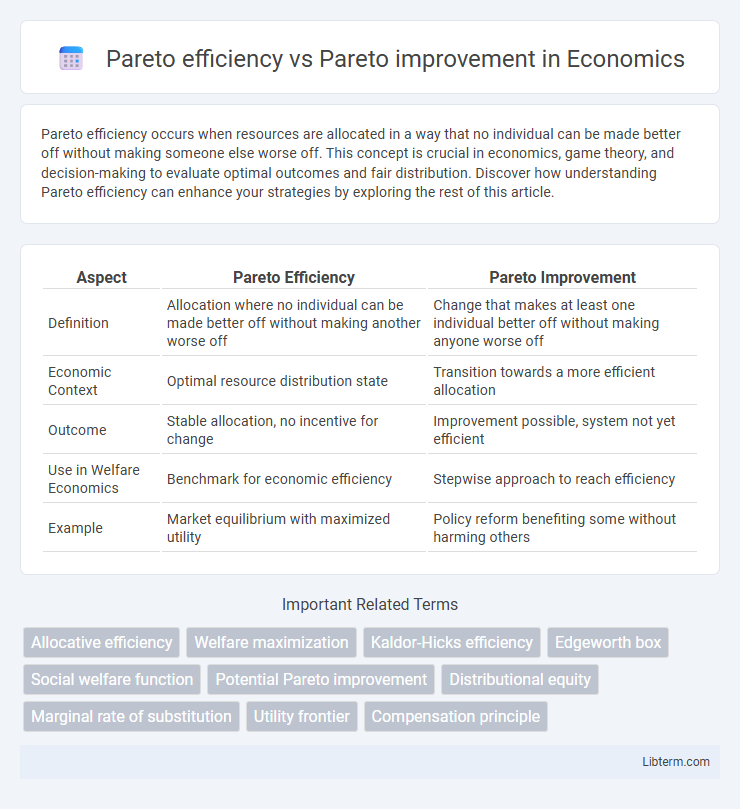Pareto efficiency occurs when resources are allocated in a way that no individual can be made better off without making someone else worse off. This concept is crucial in economics, game theory, and decision-making to evaluate optimal outcomes and fair distribution. Discover how understanding Pareto efficiency can enhance your strategies by exploring the rest of this article.
Table of Comparison
| Aspect | Pareto Efficiency | Pareto Improvement |
|---|---|---|
| Definition | Allocation where no individual can be made better off without making another worse off | Change that makes at least one individual better off without making anyone worse off |
| Economic Context | Optimal resource distribution state | Transition towards a more efficient allocation |
| Outcome | Stable allocation, no incentive for change | Improvement possible, system not yet efficient |
| Use in Welfare Economics | Benchmark for economic efficiency | Stepwise approach to reach efficiency |
| Example | Market equilibrium with maximized utility | Policy reform benefiting some without harming others |
Understanding Pareto Efficiency
Pareto efficiency occurs when resources are allocated in a way that no individual can be made better off without making someone else worse off, representing an optimal state of resource distribution. It serves as a benchmark for economic efficiency, ensuring that any change in allocation leads to trade-offs impacting at least one party adversely. Understanding this concept helps evaluate economic policies and market outcomes, emphasizing the balance between individual benefits and overall societal welfare.
Defining Pareto Improvement
Pareto improvement occurs when a change benefits at least one individual without making anyone else worse off, enhancing overall efficiency. It contrasts with Pareto efficiency, which is a state where no further Pareto improvements are possible. Identifying Pareto improvements ensures resource allocations that improve well-being without detriment, forming a basis for economic and decision theory.
Core Principles of Pareto Efficiency
Pareto efficiency, also known as Pareto optimality, is a state in which resources are allocated in a way that no individual's situation can be improved without worsening another's, reflecting the core principle of mutual non-harm in allocation. Pareto improvements occur when reallocations make at least one individual better off without making anyone worse off, moving the economy closer to Pareto efficiency. The concept emphasizes efficiency in resource distribution, ensuring that any change benefits some without detriment to others, which is fundamental in welfare economics and game theory.
Key Characteristics of Pareto Improvement
Pareto improvement occurs when at least one individual's situation improves without making anyone else worse off, highlighting a key characteristic of non-deterioration for all parties involved. Unlike Pareto efficiency, which represents an allocation where no further improvements are possible without harm, Pareto improvements signify transitional steps toward such optimal states. These improvements emphasize incremental benefits, ensuring resource reallocations enhance overall welfare without causing losses.
Comparing Pareto Efficiency and Pareto Improvement
Pareto efficiency occurs when resources are allocated in a way that no individual can be made better off without making someone else worse off, representing an optimal distribution of benefits. Pareto improvement refers to a change in allocation that makes at least one individual better off without making anyone else worse off, indicating a potential step towards Pareto efficiency. While Pareto efficiency is a static state characterized by optimal allocation, Pareto improvement describes dynamic changes that can lead to reaching or enhancing that efficiency.
Real-World Examples of Pareto Efficiency
Pareto efficiency occurs when resources are allocated in a way that no individual can be made better off without making someone else worse off, commonly seen in competitive markets where supply meets demand. Real-world examples include auction outcomes where bidders' valuations align, resulting in optimal allocation without surplus waste, and healthcare resource distribution that maximizes patient outcomes without detrimental impact on others. In contrast, Pareto improvements represent changes that can make at least one individual better off without harming others, often an initial step toward achieving Pareto efficiency.
Practical Applications of Pareto Improvement
Pareto improvement is widely applied in economics and public policy to enhance resource allocation without making any individual worse off, optimizing overall welfare efficiently. In market design and negotiation, it guides incremental changes that benefit some parties while preserving previous benefits to others, ensuring practical progress in complex systems. Urban planning and environmental policy also leverage Pareto improvements to implement sustainable changes that improve conditions without detriment, facilitating balanced development initiatives.
Limitations of Pareto Efficiency
Pareto efficiency occurs when no individual's situation can be improved without worsening another's, yet it faces limitations such as ignoring equity and distributional fairness in resource allocation. It fails to address scenarios where multiple outcomes yield identical efficiency but vastly different social welfare implications. This limitation makes it insufficient for comprehensive policy decisions that require balancing efficiency with ethical or social considerations.
Challenges in Achieving Pareto Improvement
Achieving Pareto improvement is challenging due to the difficulty of altering resource allocations without making at least one party worse off, especially in complex economic systems with competing interests and rigid constraints. Information asymmetry and transaction costs further hinder identifying and implementing changes that benefit all parties involved. These challenges often make Pareto improvements rare in practice despite being a key goal in welfare economics.
Summary: Pareto Efficiency vs Pareto Improvement
Pareto efficiency describes a state where resources are allocated in a way that no individual's situation can be improved without worsening another's, representing an optimal distribution. Pareto improvement refers to any change that makes at least one individual better off without making others worse off, indicating progress towards efficiency. Understanding the distinction clarifies that Pareto improvements are steps toward achieving Pareto efficiency but do not guarantee it until no further improvements are possible.
Pareto efficiency Infographic

 libterm.com
libterm.com